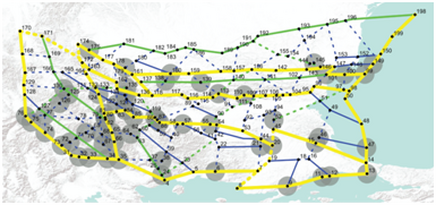For the territory of the Bulgaria and neighbouring regions, 178 nodes were defined in this work. The CORA-3 pattern recognition algorithm identified 59 seismogenic nodes analysing a set of geophysical and geological node’s characteristics. The identified seismogenic nodes are capable to generate earthquakes with magnitude equal to or greater than 6 and are located at the boundaries between the largest tectonic domains: Rila, Pirin, and Rhodope orogens; the Serbian-Macedonian massif; and in the Stara Planina belt. The set of characteristic features of seismogenic nodes indicates that the vicinity of potential nodes is characterized by a high contrast of neotectonic movements of the Earth’s crust and the presence of deep heterogeneities in the Earth’s crust. About 40% of the recognized nodes are not associated with any earthquakes, while the rest of the recognized seismogenic nodes are characterized by an area with a radius of 25 km where earthquakes are known to occur. Part of these “non active” seismogenic nodes are close to the historical events with magnitudes higher than 5.5 since the magnitude and location of historical events have large uncertainties. Another part of the seismogenic nodes may slightly change the location due to the uncertainties in morphostructural zonation. Other nodes may indicate unknown historical seismicity or paleoearthquakes. Defined M6+ seismogenic nodes can fill the potential gaps in the recorded seismicity on the territory of Bulgaria, thus to improve the seismic hazard assessment of the studied region.

Источник: Alexander I. Gorshkov, Olga V. Novikova , Sonya Y. Dimitrova, Lyuba D. Dimova, and Reneta B. Raykova (2024) Potential Locations of Strong Earthquakes in Bulgaria and the Neighbouring Regions. International Journal of Geophysics, 11: 1-13 DOI: 10.1155/2024/8103337

